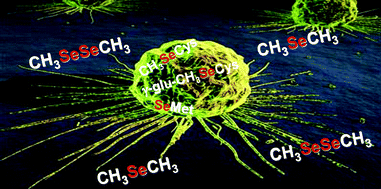A methodology using the on-line combination of micro-HPLC with ICP-MS and electrospray ionisation (ESI) MS/MS, GC-ICP-MS and GC-TOFMS is proposed for investigation of the Se species distribution in lysates and headspace of human lymphoma cell lines after incubation with methylseleninic acid (MSA), which is known as a precursor of methylselenol, a metabolite with anti-cancer properties. The HPLC-ICP-MS results showed significant differences in speciation results of control (untreated) and Se-exposed DHL-4 cells, revealing the presence of three Se compounds in the cell extracts after 10 min incubation with MSA. These compounds were preliminarily identified as Se-methylselenocysteine (SeMC), selenomethionine (SeMet) and gamma-glutamyl-methylselenocysteine (γ-glutamyl-SeMC) by HPLC-ICP-MS on the basis of retention matching with standards. Quantification of Se-compounds in cell lysates was performed by reversed-phase HPLC coupled directly to ICP-MS. Calibration was by the standard additions technique, using peak area measurements of the chromatographic signals by monitoring the 82Se signal. Verification of the presence of SeMC, the major Se compound in the cell extracts, was achieved by on-line HPLC-ESIMS/MS in selected reaction monitoring (SRM) mode. Total selenium concentrations in cell lysates were determined by flow injection analysis coupled with ICP-MS. The capabilities of solid phase micro-extraction (SPME)-GC in combination with ICP-MS and GC-TOFMS were investigated for studying the distribution of volatile Se species in the headspace of the lymphoma DHL-4 cell cultures. A cryogenic oven cooling (COC)-GC system, which led to a significant improvement in the chromatographic performance (retention time, peak shape and consequently, chromatographic selectivity) of compounds with a low boiling point such as dimethylselenide (CH3SeCH3) in comparison with conventional GC was employed for the first time. A number of volatile Se species could be detected by GC-ICP-MS, from which dimethylselenide and dimethyldiselenide (CH3SeSeCH3) could be identified by COC-GC-TOFMS in the headspace of DHL-4 cell lines exposed to methylseleninic acid.

You have access to this article
 Please wait while we load your content...
Something went wrong. Try again?
Please wait while we load your content...
Something went wrong. Try again?


 Please wait while we load your content...
Please wait while we load your content...